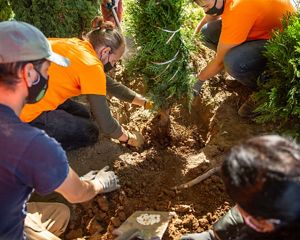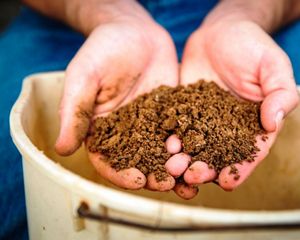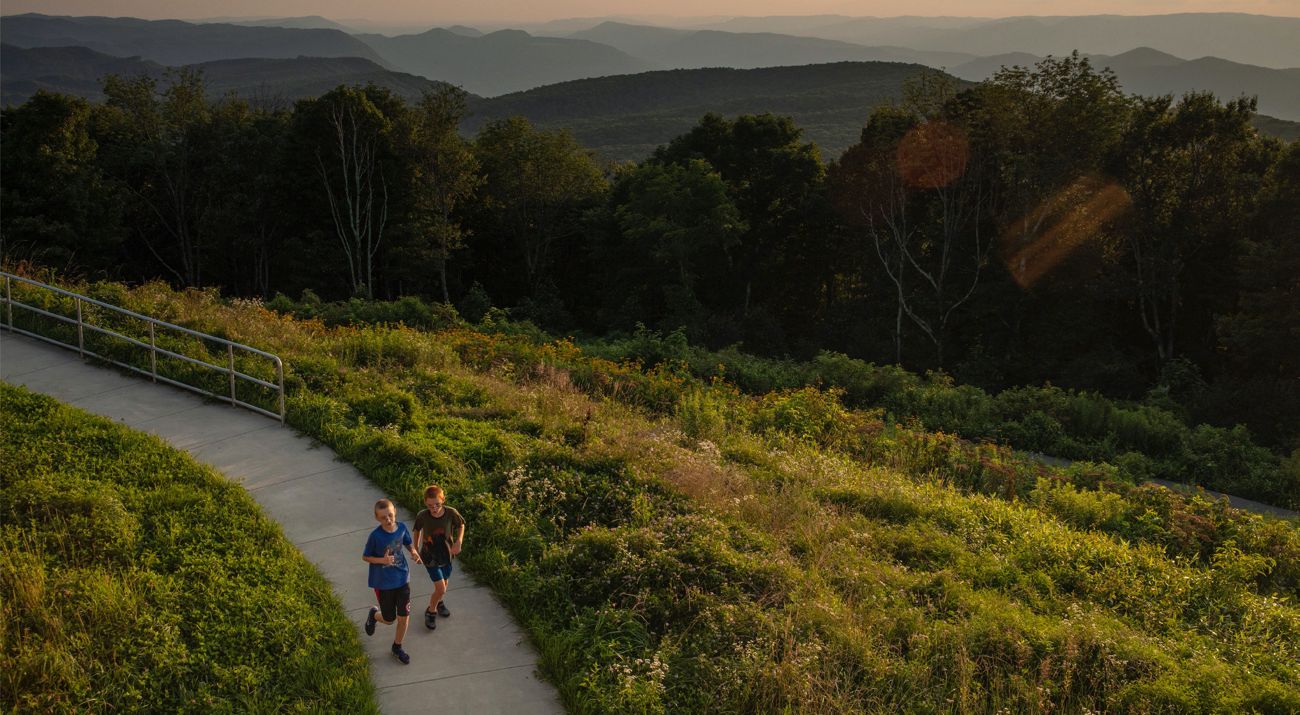
Our commonwealth benefits from many Kentuckians who focus on conservation in their daily lives. From farmers who practice conservation agriculture to wildlife biologists who practice science-based management, inspiring stories abound from Kentuckians who put nature first. This series introduces you to these individuals in a Q&A format to amplify Kentucky voices through unfiltered conversations that bring them to life.
If you are a conservationist and have a great story to tell, get in touch with us! Email kentucky@tnc.org and reference Kentucky Stories.
Boone Bowling
Boone Bowling is the mayor of Middlesboro, Kentucky. A lifelong Middlesboro resident, he envisions a revitalized Appalachian Mountains region that embraces new technologies such as solar energy.
Quote: Boone Bowling
One of the greatest things about the solar installation project at the Community Center is I think it's really going to be be an eye-opener.
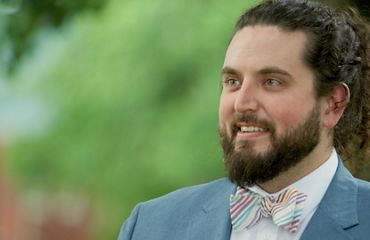
What do you love about Middlesboro, Kentucky?
One of the most special things about Middlesboro is that it's one big family. You're home no matter where you're at, what roof you're staying under, it's home.
What are some of the challenges?
You know, the toughest thing here in this area would most certainly be just because we are so remote, sometimes we don't have those same opportunities that most do. When the coal industry left here, it crippled our community. Although we knew it was coming, sometimes there wasn't that leadership to be there to blanket the impact that it was going to have.
What opportunities are you seeing that could help alleviate these challenges? How does the Community Center solar installation project tie in with these opportunities?
We see more and more on the news that solar, wind turbines, and other renewable sources of energy are being used. But, you know, we've never seen that here. One of the greatest things about the project at the Community Center is I think it's really going to be be an eye-opener for multiple people to see what it's done for this area. That building is the main staple point in our area. Everything from weddings to birthdays to graduation parties; that is the only venue we've had. And to see a building that has been used by every family in our area be supported and run off of solar electricity, that's going to be a good stepping stone to open up more opportunities and make people see that there are other resources outside of just coal.
Quote: Boone Bowling
I just want to say thank you to The Nature Conservancy and Mountain Association. This gives us a vision, this gives us an image of what a newer energy source will be like here in this community.
Tell us about the partnership between the City of Middlesboro, The Nature Conservancy, and Mountain Association?
One of the greatest things about the partnership we've got now is it's a new opportunity we've not seen since coal. This is an investment in the community. If somebody can drive down the road and see the solar panels or they look up on the community center and they can see new construction up there and, it gets people wondering, what is that? And then you can advocate and say, that’s The Nature Conservancy.
Can you talk about investing in this area and its people?
Just seeing an investment is something that we're not used to. We're loyal to those who invest in us. It’s just like any kid around town; when you make an investment in them, then they don't want to leave. They want to stay here. And by investing in us, it gives us hope. We're not used to seeing community solar projects, but we are opening that door. Just the visibility of being able to see that change and not just hearing about it, has been a pivotal point in our community.
I just want to say thank you to The Nature Conservancy and Mountain Association. You all don't understand what this is going to do for our community and the doors that are going to be opened. This gives us a vision, this gives us an image of what a newer energy source will be like here in this community.
The greatest thing about this investment for the future would have to be that it's the tip of the iceberg. This is something that is out of the box and something we're not used to. The opportunities that are ahead are just, they're all there. It's a story that's yet to write itself.
If we can continue to build on this, which is going to save us so much money over the years, what can we do to reinvest that money in our downtown? What can we do to reinvest that into real economic development opportunities to recruit businesses, to be sustainable, to start making high speed internet more than just a thought. It's just exciting for all the opportunities that could spin off from this.
The community center overall and that project are going to be the first big leap. It's not going to be the first step, but it's going to be the first leap. And that's so exciting to me and this whole community.
Kathy Terry
Kathy Terry is a natural resource specialist with the Natural Resources Conservation Service (NRCS), a close partner with TNC. She loves to collaborate with western Kentucky landowners to restore frequently flooded cropland to bottomland hardwood forests, benefiting people and nature.
Quote: Kathy Terry
The Mississippi River Basin is just a vibrant expanse of habitat and wetlands. It’s just awe-inspiring and amazing to be able to work in this area.
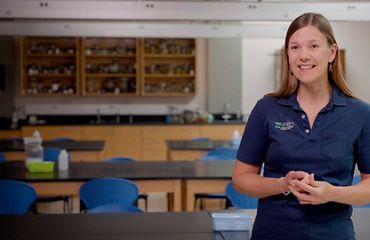
What do you love about the Mississippi River Basin?
The Mississippi River Basin is just a vibrant expanse of habitat and wetlands. All that just runs down the whole United States, and there's nothing else like it anywhere. It’s just awe-inspiring and amazing to be able to work in this area.
Why is the basin so important to people and nature?
The basin is important to people. They make their livelihoods in the basin, farming and fishing, barge traffic, taking food up and down the river, grain and things like that. And the wildlife, it's just amazing the diversity of wildlife that use it up and down the whole country.
Why are the basin’s wetlands so important?
The wetlands are important because they are the area between the river and the upland. You need your wetlands along any river to help with flood control. They act like a sponge. And to provide that wildlife habitat, there are nursery areas for a lot of fish and other animals. They control sediment and nutrients from getting into the river. They act like filters, so they're very important.
Can you talk about how nutrients can be excessive?
There are inputs in agricultural lands, phosphorus and nitrogen, to help make a healthier soil for growing vegetation. When every farmer all the way down the Mississippi River is inputting into their soil, it's going to run off. You probably have more than you need. And when it rains, it just runs off of the farmland because there's nothing to hold it there. So, you have more nutrients than you need and then they accumulate in the water. And that's where we have the dead zone in the Gulf where things can't live. It's too much. Wetlands can help filter out some of that to help it seep into the groundwater in a more clean way.
Quote: Kathy Terry
The partnership between NRCS and the Nature Conservancy is a longstanding one. The Nature Conservancy has been integral in helping implement what's called the Wetland Reserve Enhancement Program.
What has happened to our wetlands over time here in Kentucky?
Over time, 80 percent of our wetlands have been cleared and drained. A lot of that is for agriculture and homes.
Tell me about wetland restoration programs. How do they work?
The program that I work in is called the Agricultural Conservation Easement Program for the Wetland Reserve Easements. The reason for this program is to try to restore these wetlands that have been lost over time. It’s a Farm Bill program and people are compensated for doing this. If you have a farm that has wetland soils on it that have been cleared and you have a hard getting a crop in because it's too wet in the spring, or harvesting a crop in the fall because it's flooded a lot, the program allows the landowner to be able to take put this land into the wetland restoration easement program. Landowners are compensated at 95 percent of fair market value in Kentucky for that land, but they still own it.
And then NRCS comes in and we restore it back to a wetland by planting bottomland hardwood trees on it and by trying to restore the hydrology where we can to hold more water on it, because a lot of them have been ditched and drained.
The landowner can hunt it, they can use it for birdwatching and wildlife habitat. It’s a win-win for people and nature. If they sell the land down the road, that easement stays with the land permanently.
Can you talk a little bit about the partnership between NRCS and the Nature Conservancy?
The partnership between NRCS and the Nature Conservancy is a longstanding one. The Nature Conservancy has been integral in helping implement what's called the Wetland Reserve Enhancement Program, which is extra funding for these wetland reserve easements in a targeted area. TNC has helped with proposal writing and providing match compensation for these easements. Without the Nature Conservancy's partnership, we wouldn't have been able to get more wetlands on the ground.
What are your hopes for the future of the basin and its wetlands?
My hopes for the future of the Mississippi River Basin and its wetlands are that they continue to thrive and be restored. Our nation deserves to have these wetlands that were here before, and our children need to be able to see what it was like before we cleared them.
I think that the more restoration we can do to replace some of those wetlands that have been lost will be helpful to communities along the river, to farmers up and down the river, and to the people and wildlife who use the river and its wetlands. It’s just very, very exciting to work in a program where you can see a farm field go from a soybean field to a bottomland hardwood forest in just a short amount of time.
Derrick Mason
Derrick Mason is a wildlife biologist in Louisville, Kentucky. He earned a bachelor's degree in wildlife management from Eastern Kentucky University and has worked for the Kentucky Department of Fish and Wildlife Resources and Resource Designs, Inc. Derrick wants to see more urban African-American kids get outside and enjoy nature, and considers climate change to be our most pressing conservation issue.
How did you learn about The Nature Conservancy?
During my junior year of high school, Chris Chandler came in to talk about TNC’s internship program during class. It was the first time I’d ever heard about TNC. I applied for the internship. They asked me questions about how I worked in a team, our general values and specific situations. I think one of the reasons I got the internship was because of my participation in our school’s environmental club. The summer internship was June through July.
What was your internship like? What did you learn?
We stayed in Steamboat Springs, Colorado at the Carpenter Ranch. I’d never seen snow on a mountaintop before; that was pretty neat. My crew did a lot of trail maintenance on the ranch. It was a very popular birding spot. Throughout the week we would have different projects. We had a schedule for each week: We would go somewhere, collaborate, and work with either local or state agencies. For instance, we got to create a Hügelkultur at a botanical garden. You dig out a giant portion of land, throw in dead logs and wood and cover that up.
Near southeastern Wyoming, we worked with Colorado’s Parks and Wildlife agency to survey toads for chytrid fungus. The fungus has been killing toads and other amphibians at alarming rates.
We did a lot of sightseeing. We went to the state college of Wyoming and to Boulder, Colorado to look at a couple of their colleges. We hiked up more than 12,000 feet to reach the peak of Medicine Bow at the Medicine Bow National Forest. I was determined to get to the top, but some of my friends got altitude sickness. Only a couple of us eventually made it.
Quote: Derrick Mason
I went to Eastern Kentucky University. I definitely felt like a fish out of water coming from an urban area.

How did you know you wanted a career in conservation?
It was definitely during my TNC internship that I knew I wanted a career in conservation. We did a couple of interviews about how the internship went and what we wanted to possibly do. Throughout my time working, I was just thinking, "this is enjoyable." I’d rather spend my days doing this for the rest of my life.
That set me on a track to go to school for wildlife in general. During the internship, the best things were the toads and hearing the coyotes in Wyoming. Not being able to see two feet in front of me was pretty crazy—we camped out there—worked, camped and worked again. That was insane—I’d never seen that many stars. It was like being in a dark room, but I was outside.
Can you talk about your education? What led you to wildlife biology?
I went to Eastern Kentucky University. I definitely felt like a fish out of water coming from an urban area. I guess it got easier as time went on. I wasn’t the best student, but I was learning which study methods worked for me. There were things that just stuck when it came to learning, especially what I was learning in my biology courses compared to my gen-ed courses.
I did a lot of field work outside of class such as wetland delineation, identifying species and statistics. It was required to succeed in senior courses. River cane surveys were part of my last project. My partner, Morgan, and I gathered our data within the Taylor Fork ecological area at Eastern.
All of the connections that I made, all the people I met, were great and the best part about Eastern. I thought I was going to go in and come back out and run back to my mom, but they were very supportive.
What were your first couple of years of work like?
I was a summer camp counselor at Camp Curry for the Kentucky Department of Fish and Wildlife Resources. After that, they hired me for a temporary position as a conservation educator for about three months. And right after that, I got to work extra by collecting lymph nodes from deer to test for chronic wasting disease. Now, I work for a private contractor as a wildlife biologist.
What are some of the biggest issues in conservation and wildlife biology that you’re tackling in your work?
The politics are the hardest thing. Getting the correct information about climate change and making it digestible for the general population is a struggle. You can state facts and have statistics and things like that, but people aren’t going to read it. You have to reduce it down to something that’s easy. We just don’t like to talk about it. Most of my classes had sections of “doom and gloom.” You get used to it. I’d like to spread good news in the future.
I try to keep up with all that goes into global warming. The thing that scares me the most is our lack of freshwater, and the rise in temperatures when it comes to our oceans because they literally affect everything. The urbanization of unprotected wildlife areas hits very close to home for me. I worked at a Kroger when I was in high school. There was a coworker who used to turkey hunt where I lived at the time. I’ll remember that story until the day I die. I can’t believe that all of that land turned into suburbs that fast.
What would you tell someone who was thinking about a career in conservation?
I would say that your motivation has to be about how passionate you are about the work rather than the money you make. You have to be willing to move to work. Money’s going to be tertiary. I was lucky to find a job in Louisville.
What gets you up in the morning to do this work?
The number one thing I think about is, as a student, how I would feel if I saw an African American in the wildlife field. What gets me going is being a role model and an inspiration for younger people that look like me and grew up in the same areas that I did. Just trying keeping people interested in going outside.
I was the only person of color in my class to graduate with the major that I had. I often felt disconnected because I wasn’t raised in a rural background. You gain knowledge by living in areas like Somerset, Prestonsburg or northern Kentucky when it comes to wildlife. Coming from Louisville, the things I learned in school prepared me for what to expect in Louisville, not in nature. I do wish I knew about the parks throughout Louisville growing up. Now, I to go to Jefferson Memorial Park or to Turkey Run to hike with either my girlfriend, Allie, or my buddy, Peter.
Robbie Williams
Robbie Williams manages a multi-generational farm in Henderson, Kentucky. Robbie Williams Farms is partially powered by solar and geothermal energies, and Robbie has helped dozens of friends and neighbors make the switch to solar energy. He believes we must all be part of the solution to climate change.
What was it like, growing up on a farm?
I was blessed to be in a very nurturing environment. My mother had a business in town and my dad farmed. My two grandparents’ farms adjoin—all four grandparents on two farms. I came from a very nurturing, stable, loving family and a very educational, nurturing environment.
What do you love about farming?
There are always opportunities to do things for others; There are always opportunities for problem solving. There’s always a higher purpose: for example, feeding people or environmental concerns. I always say that a good farmer and a good environmentalist are the same thing.
How do farming and caring for the environment relate to each other?
Farming is very energy-intensive. Farming impacts the soil and water. Everything a farmer does is on a big scale and has a lot of impact. Farmers use a lot of energy and farmers have a long-term perspective, especially if you’re farming land that has been in your family and your landlord’s family for generations. There’s a continuity that you want to enable the dreams of others, much in the same way you were brought up yourself and you were enabled.
I have worked on 24 solar arrays locally; I’m building three right now. Energy is just something that you’re keenly aware of. Frankly, I think that the more clean energy we can switch to, the more it protects fossil fuel resources. You take things like a combine harvesting grain that probably has a 500-horsepower engine running at 10 hours a day. We don’t have technology anywhere where batteries can handle those loads, like a tillage tractor or a combine. That’s not to say we shouldn’t aspire to get there someday. That’s not to say we shouldn’t use clean energy on a scale that’s possible. There’s no reason my car can’t be electric. We consume a lot of fossil energy but there’s no reason we can’t conserve energy with geothermal. It’s important that we should develop an energy mix and figure out how we can make everything work together.
What else can farmers do to address environmental issues like climate change?
No-till and minimum-till farming returns carbon to the soil, and there are other soil conservation measures like reforestation and cover crops. All of those things protect the air and water. For example, when the rainforest in south America is degraded, there’s tremendous carbon released into the atmosphere. We can always do a better job here with minimum till and no till. We should avoid aggressive tillage as much as possible.
What are you doing to ensure your farming operations are more compatible with nature?
Solar is kind of my thing lately. I would say that we do as much minimum or no-till as possible, and we’re keenly interested in energy. We produce far more electricity than we consume. I’m proud that we provide clean energy to our neighbors through our local cooperative, Kenergy. We have a very positive relationship with them. My energy provides a percentage of clean energy for our neighbors, and that would not be possible without our local electric cooperative.
How much solar energy do you produce on your farm?
Altogether on the home farm, we have about 270 solar panels. That powers our whole farm—that and then some. It keeps the lights on, and powers grain bin fans, geothermal heat pumps, and multiple shops. We produce about 100,000 watts of electricity at peak output.
Keep in mind, this still requires an energy mix. Right now, energy storage technology is in its infancy. At night when the sun’s not shining, we’re running on fossil energy. We’re producing more energy during the day, but we still rely on fossil fuels at night. I think it’s positive to reduce fossil energy. But we have to make this all work together.
I think the political environment is such that everything is all or nothing, red or blue, renewable or not. We should not think of everything like that. Science in general should never be politicized. When something is politicized, it develops shallow, incorrect conclusions. We need to move forward with scientific facts. We can promote renewables all the while knowing we have to have fossil energy for some things. We need to be thinking, how do we make different forms of energy work together?
What about solar siting?
This is something very, very important. There are utilities that are buying up prime cropland and putting up utility-scale solar arrays. And there are people becoming very negative toward solar because they may be losing a farm.
I make the argument that if more individuals took a steep hillside out behind the barn or an unused lot not suitable for crops, and installed solar, that would mitigate the need for turning these huge farms into solar farms. Furthermore, that energy would be distributed and reliable. It would be more resistant to storms if it’s not all in the same place. I think every farmer would have a suitable place to install a solar array on the farm.
We as a society should not be consuming premium cropland for utility-scale solar farms when we could be doing it on a more distributed basis. We could be using reclaimed strip mine land, closed landfills, and things like that. You don’t see that happening. It’s a little bit more of an engineering challenge, but right here in Henderson County, Kentucky, we have reclaimed strip mines with power lines going straight through them. There’s talk about putting solar arrays on them, and I hope that happens. There are more appropriate places to build solar than on premium cropland.





